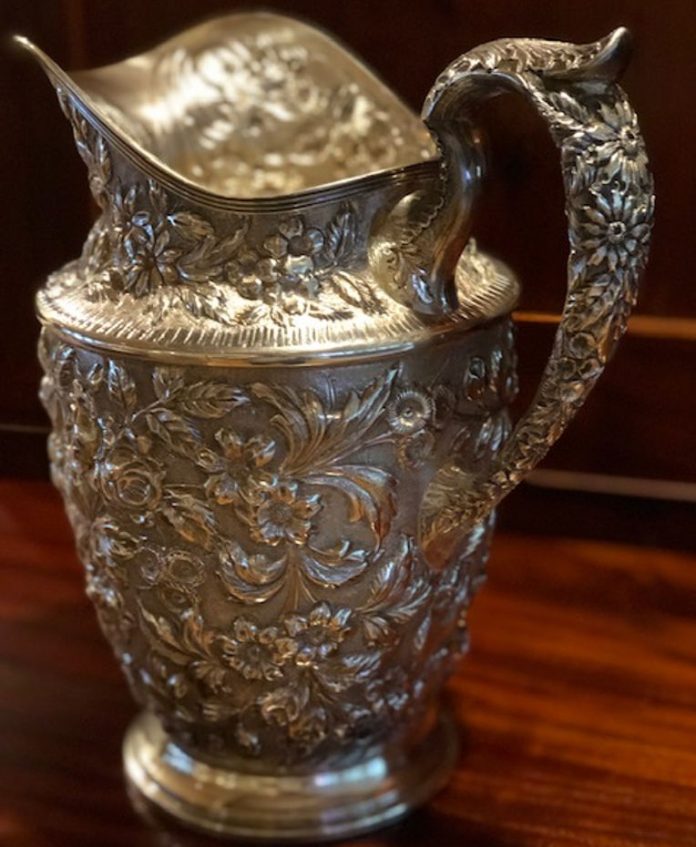NOTE TO READERS: Beginning in April 2019, the regular “What Are They Worth?” column for The Oregonian/OregonLive will be revamped with a new emphasis on the collectibles, home furnishings and decor items that are most in demand in today’s marketplace. Today’s Collectibles will continue to accept submissions from readers in all categories but will feature only those that are in low supply and high demand today.
We believe this new emphasis will help our readers understand the trends and make good decisions about what to buy, what to sell and what to keep. Please read to the end of this month’s column for information about submitting items to be featured.
Silver pitcher
Courtesy of the collector
Silver pitcher
Q. I have a 9.5-inch-high sterling milk pitcher heavily repousséd with floral patterns. A highly reputable antique appraiser from Seattle appraised its replacement value at $8,000. However, we took it to a reputable jewelry store that brings in silver buyers once a year and they offered us $150! So, who do we believe?
— T.O., Seattle
A. This is a sterling silver water pitcher, in the “Baltimore Rose” pattern, by the Schofield Silver Company, which was in operation from 1903 to 1977 in Baltimore, Maryland. Baltimore Rose, their best-known pattern, was introduced around 1905. Repoussé is the technique of creating designs by hammering a soft metal from the reverse side. An auction estimate might be $1,200 -$1,800. Retail silver dealers are currently asking $2,750-$3,500 for this model.
Henry Miller book and prints
Courtesy of the collector
Henry Miller book and prints
Q. I have an Edition G of Henry Miller’s “Insomnia or the Devil at Large,” a first edition printed by Loujon Press in 1970 and housed in a handmade wooden box along with 13 prints of Miller’s watercolors done for this edition. Three of the prints are hand-signed in pencil by Miller. There were only 300 of these made before the publisher died.
— S.P., Grants Pass
A. At the age of 75, famous American author Henry Miller fell deeply in love with 25-year-old nightclub singer Hoki Tokuda. He wrote “Insomnia” about this experience and painted 12 watercolors to help illustrate his feelings. This book and lithographs of the watercolors were produced by Loujon Press of Albuquerque, which presented them in a specially made wooden portfolio box. A bookseller would likely ask $2,000-$2,500 for this edition, although the price might be higher, considering the signed prints. At auction, similar editions have sold for $1,000-$1,500.

Thonet rocker
Courtesy of the collector
Thonet rocker
Q. This chair was originally bought in the Midwest in the ’70s. What if anything can you tell me about it in terms of maker, time period and value?
–M.B., Southwest Portland
A. Michael Thonet (1796-1871) was an Austrian furniture maker whose designs have become some of the world’s most famous. He perfected the art of bending beech wood with heat to form furniture — especially chairs — that were graceful, lightweight and strong. At its peak, the Thonet company was producing almost two million pieces of furniture each year. When the last Thonet patent expired in 1839, other bentwood companies sprang up. By the end of the 19th century, there were hundreds throughout the world. Thonet went through multiple company changes in ownership and location, with factories throughout Europe and several in the United States. The U.S. branch — Thonet Industries — was sold to Shelby Williams. In 1999, both of those companies were sold to CFGroup, a manufacturer of a wide range of industrial furniture. Your chair is an example of a Model 10 Thonet bent wood rocker with caned seat and back panels. It probably dates from around 1965. At auction, you might expect a sale of $200-$300. Examples of this model chair, of this age, in nice condition, are currently offered in the retail market for $500-$700.
Source






































